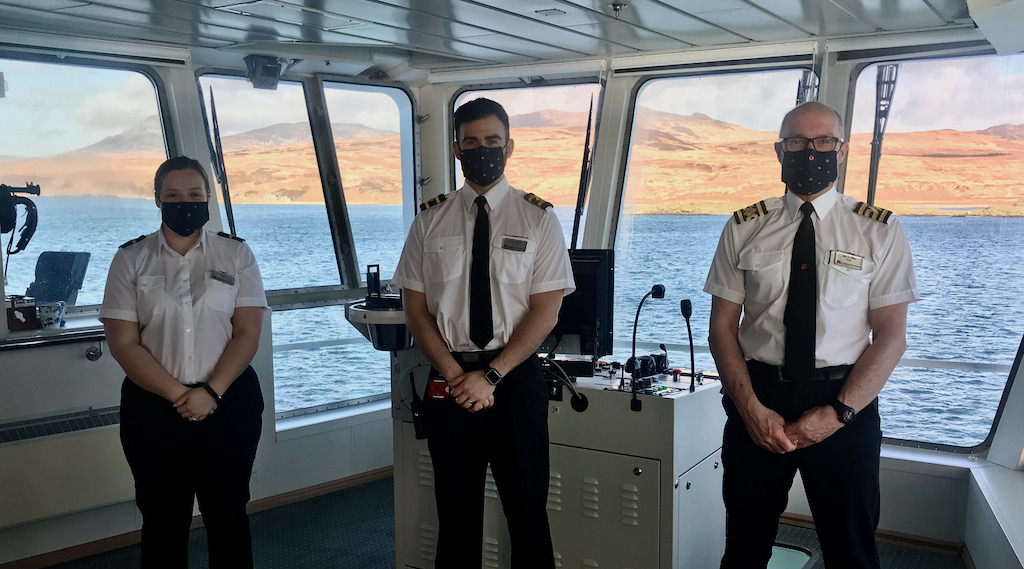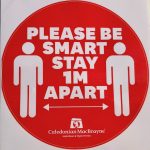
Bridge bubble: Captain John Gillies (right) on MV Finlaggan on 25 February 2021, with 2nd Officer Marino Giorgetti (centre) and 3rd Officer Emma Somerville (left). Captain Gillies says CalMac safety protocols have made crews “so much more prepared now” compared to the start of the pandemic. But if the service is busy and the weather bad, everyone congregates indoors and it becomes “tight and claustrophobic. That makes people nervous.”
As the easing of lockdown restrictions approaches, Captain John Gillies tells CRSC’s Andrew Clark how the coronavirus pandemic impacted on the men and women who have kept CalMac services going over the past year.
There is a bridge bubble, an engineering bubble, a retail bubble, a deck bubble: welcome to segregated life in lockdown.
“We’re getting better [at managing the restrictions] all the time, and we do try to avoid each other,” says Captain John Gillies, 61, referring to the way CalMac crew members limit contact to their own onboard team. As one of the company’s most experienced masters, currently alternating between Finlaggan and Loch Seaforth, Captain Gillies has the responsibility of ensuring that anti-virus protocols are strictly enforced. It’s not easy.
“Part of shipboard life is the ‘craic’,” he says, “but we now have to be as anti-social as possible. You can’t just walk into the engine room — you can’t even sit in the mess room together. In a ship, that’s difficult.”

Captain Gillies was interviewed on a FaceTime video call last weekend while he was at home on Raasay. He currently divides his working time between Finlaggan and Loch Seaforth, but expects to join Hebridean Isles in March
Captain Gillies, 61, has the sea in his blood. Born and bred on Raasay, the son and grandson of men who spent their working lives on the water, he went ‘deep sea’ as a teenager, travelling the world on bulk carriers before eventually settling down to a career with CalMac. Nothing — not the rounding of the Cape nor the worst storm in the Minch — prepared him for the challenge of maintaining a service to the Scottish islands throughout a year-long pandemic.
In the eyes of many passengers, at least in the opening months of lockdown, the job of enforcing restrictions fell to shore staff, trying to sift out non-essential travellers. Behind the scenes, office staff had an equally tricky task, matching crew and vessel deployment to rapidly changing government regulations and fluctuating traffic flows.
But the people who have kept the ships actually moving these past 12 months — the ‘frontline workers’ exposing themselves to risk through contact with each other and the travelling public — are the crews.
“When you’re confined to a ship for two weeks [under pandemic restrictions], it’s very easy to feel ‘down’, especially when you have pressures at work or home,” says Captain Gillies, referring to mental health problems at sea under lockdown. “When you’re not socialising, these build up.”
The fact that services have been so well maintained is a tribute to all CalMac staff, working in unprecedented conditions. Looking back on the weeks since Christmas, Captain Gillies speaks with relief about how “everyone is so much more prepared now”, thanks to the company’s evolving Covid protocols, built up on a weekly — sometimes daily — basis, to establish and maintain working practices that minimise the risks.
“It was very difficult at the start just to keep things going,” he recalls, referring to the speed with which everything changed last March, when office staff stopped coming in to work, video conferencing had barely been invented and face masks were anathema to the general public. “There were so many unknowns — it was a strange time. There was an almost tangible nervousness on board. The cafeteria and observation lounge were closed. Crew meal times had to be staggered. There was constant cleaning and disinfecting. You had to do handovers by notes or socially distanced meetings in a car park — not face to face. At every crew change, you started wondering if the new lot, coming in from everywhere, were bringing it on board. Even discharge books had to be disinfected. You just didn’t know how exposed you were to the virus.”
In those early weeks of restricted travel, a limit of 170 passengers was set for Loch Seaforth, though the number of people travelling on each crossing rarely exceeded 50. Even now, with a limit of 300, social distancing is “quite easily achievable” on a ship of that size. But if the ‘Seaforth’ is busy and the weather bad, everyone congregates indoors and it becomes “tight and claustrophobic. That makes people nervous.”

Departure lounge at Oban under Covid-19 restrictions. Shore staff bore the brunt of public frustration during the early weeks of lockdown
An islander himself, Captain Gillies recognises the importance of island sentiment. Throughout the pandemic, islanders have been noticeably more nervous about infection than town- and city-dwellers. “Nobody wanted to be the person who caught the virus and spread it to the family, and none of us [on the ferries] wants to be the transportation that carries it to the island communities. On Loch Seaforth we segregate ourselves even from the drivers of tug masters [the tractor units that haul container trailers on and off the ship] because they go home at night.”
One of CalMac’s anti-Covid measures was to keep crew numbers to a minimum, though this was not without problems. With some personnel having to shield because of asthma or a heart condition, ships could suddenly find themselves in danger of being under-manned. Short-term replacements had to be found, breaking up the ‘team’ and increasing the risk of virus-spread. Captain Gillies himself had to self-isolate at the end of last year when one of his previous ship’s onboard bubble tested positive, though it turned out to be a false alarm: a second test came back negative.
“We’ve been living with it so long now that we forget the nervousness and panic at the start,” he observes. “The biggest eye-opener for me was when the first lockdown was lifted. The previous Saturday we had carried just a handful of lorries and a few key workers. The next Saturday we were back to high summer numbers, with both mezzanine decks full. That’s the way the public looked at it — ‘the restrictions are lifted, the virus has gone’.”
The halving of social distancing to one metre last July improved the atmosphere on board, as did the more recent reinstatement of retail services — but policing the rules has been awkward. A family travelling together are allowed to sit together, “but you can’t tell if they’re all family. We used to get complaints from other passengers. The retail staff have taken the brunt of it, just facing the public: they have a tough shift. We’re getting better all the time at managing the restrictions, but [as a master] you get to the stage on a Monday morning when another amendment comes in, and you fear it’s going to go down [among the crew] like a lead balloon.”
Captain Gilllies nevertheless pays tribute to his shipmates: “A lot of people are very constructive, finding ways to do it. They know the importance of keeping the community safe. Everybody looks out for each other. Something must have worked — there have been very few cases of Covid in the Western Isles.”
He says the changed dynamics of communicating with office staff by Zoom has opened up a new way of working, despite the often unreliable internet connection at sea. “We muddle along. It’s going to take a long time to get back to a ‘normal’ routine.”
This is the first instalment of a two-part interview with Captain Gillies. The second part, ‘John Gillies: a versatile Hebridean master’, can be read here.
© CRSC. No reproduction of text or pictures without written permission: info@crsc.org.uk

Loch Seaforth approaching Stornoway on 12 February 2021. Captain Gillies has been associated with the ship since she was handed over by her builders in Germany in 2014. In the early weeks of the pandemic she was limited to 170 passengers, but often sailed with a third of that number

Finlaggan leaving Port Ellen on 14 November 2020, captured in a spectacular shot by David Livingstone. Captain Gillies says that ‘None of us [on the ferries] wants to be the transportation that carries the virus to island communities’
Published on 26 February 2021












